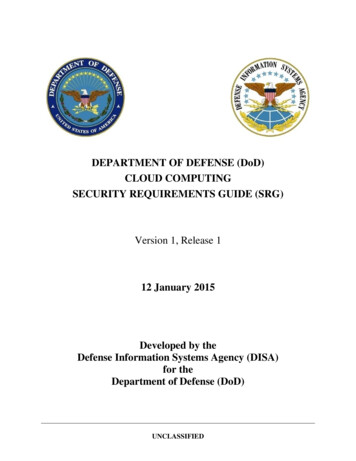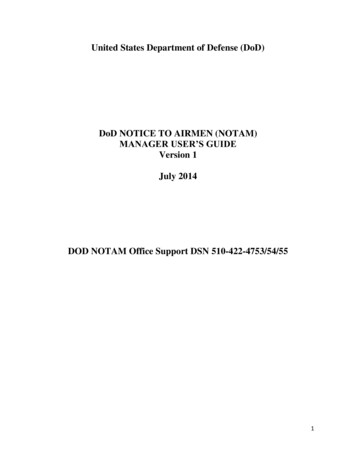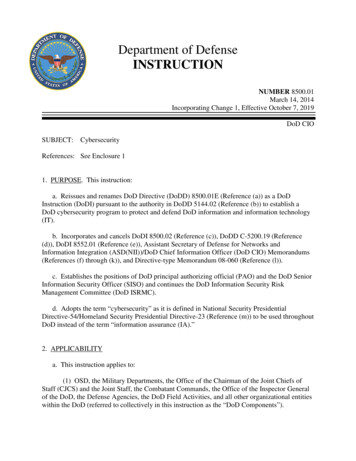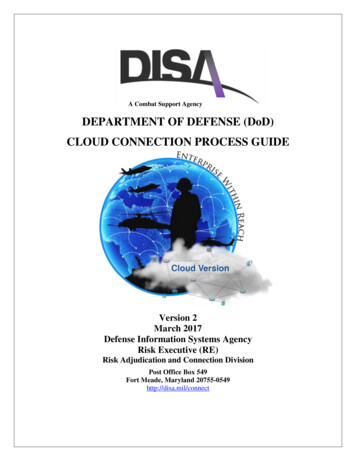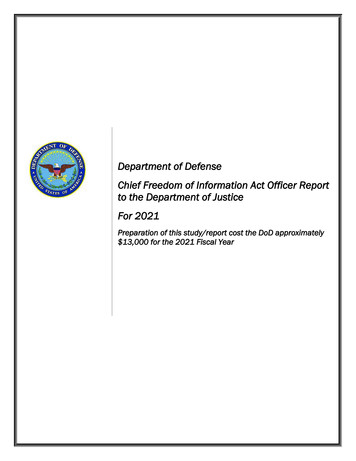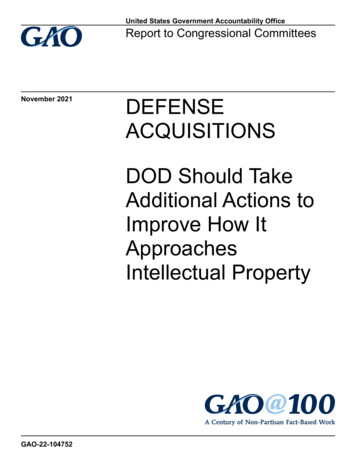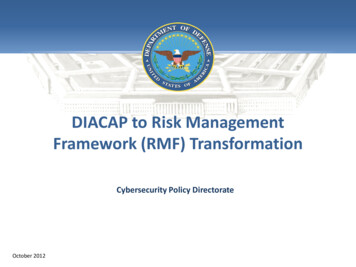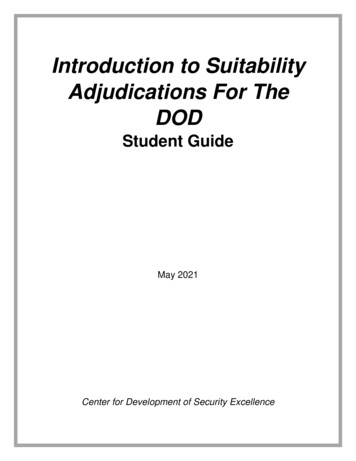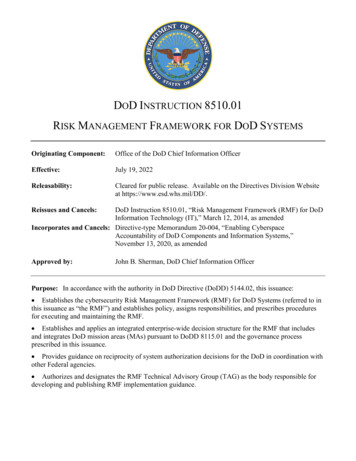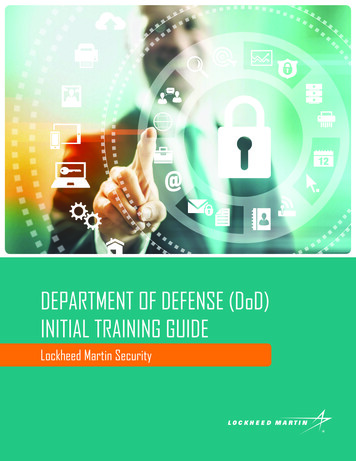
Transcription
DEPARTMENT OF DEFENSE (DoD)INITIAL TRAINING GUIDELockheed Martin Security
TABLE OF CONTENTSCongratulations2Introduction3Reporting Requirements4Procedures and ntion/Disposition6Classification g the Non-Disclosure Agreement10Glossary11LOCKHEED MARTIN PROPRIETARY INFORMATIONDoD Initial Training Guide 1
CONGRATULATIONSYou have been granted a Department of Defense (DoD) security clearance andconsequently the U.S. government has provided authority for you to accesscertain classified information.As a newly cleared individual, there are basic security concepts you will need tolearn. This training guide will provide the foundational knowledge, expectationsand requirements you will need to understand prior to beginning work. After30 days, you will take an online course that will recap much of this information,along with scenario-based exercises that will test your understanding of thematerial. You will also get to know Security Professionals who can assist andguide you in maintaining a strong, defensive security posture.Thank you for your attention to this important topic, and welcome aboard!Bob TronoVice President & Chief Security OfficerLockheed MartinDoD Initial Training Guide 2
INTRODUCTIONINDIVIDUAL SECURITY RESPONSIBILITIESThe U.S. government has established detailed requirements which are outlined in the National Industrial SecurityProgram Operating Manual, or NISPOM, to ensure the protection of classified information. Part of your role asa cleared Lockheed Martin employee is to protect our nation from a variety of threats. Our National Security isconstantly under attack by adversaries both foreign and domestic; by protecting classified information, you arefulfilling a critical role in protecting our nation.This training guide will provide security procedures that are critical for cleared employees to understand andcomply with government security regulations. Although each cleared facility adheres to set government securitystandards, implementation procedures may vary from site to site.PENALTIESPenalties for unauthorized disclosure of classifiedinformation, which can be assessed against bothcleared employees and the corporation, include: Fines of up to 10,000 Imprisonment of up to 10 yearsFor defense contractors such asLockheed Martin, the Defense SecurityService (DSS) is the primary DoDsecurity agency assigned to oversee theprotection of classified information.DoD Initial Training Guide 3
REPORTING REQUIREMENTSNow that you are a cleared employee, there are a number of reporting requirements you must adhere to inorder to maintain your security clearance. These reporting requirements are centered on events and activitiesthat could potentially impact your ability to protect classified information.CHANGE IN PERSONAL STATUSADVERSE INFORMATION NameYou must also report information that reflectsunfavorably on the integrity or character of yourself oranother cleared individual that may impair the abilityto safeguard classified materials. This information isdefined as adverse information. Citizenship including acquiring dual citizenshipand/or foreign passports Residence Marital status Cohabitation in a spouse-like relationship with aforeign national Job assignment no longer requiring a securityclearanceSUSPICIOUS CONTACT Any contact with an individual that is suspicious innature, whether they are a U.S. or foreign person Someone taking an unusual interest in you andyour job and/or asking probing questions aboutwhat you do and who you work forThese contacts can occur online, through social media,email, via phone, written correspondence, or in person.Some examples of suspicious contacts include: Request for protected information under theguise of a price quote or purchase request, marketsurvey, or other pretense Attempts to entice cleared employees intosituations that could lead to blackmail or extortion Attempts by foreign customers to gain accessto hardware and information that exceeds thelimitations of the export license on file Attempts to place cleared personnel underobligation through special treatment, favors, gifts,or moneyThese reports should be made to the local SecurityOffice or to the LMPeople system internally. If indoubt as to whether something is reportable, consultwith your Security Office.Some examples of adverse information include: Known or suspected violation of security rules byyou or another individual Known or suspected compromise of classifiedinformation by you or another individual Any arrest, criminal activity, or civil court actions- Traffic fines over 300 (not including court fees) Treatment for psychological, mental, emotional,and personality disorders and counseling, exceptfamily/marriage, grief and combat-relatedcounseling (unless the counseling was precipitatedby a violent action or event) Substance abuse Medical marijuana (prior to use) Use of illegal controlled substances (which includesmarijuana under federal law) Unexplained affluence Excessive indebtedness or recurring financialdifficulties (e.g., foreclosure or bankruptcy) Knowledge of an employee not wanting to performon classified work Close or continuous contact with a foreign personor entity Misuse of any company or U.S. governmentinformation systems Behavior that causes an individual to be vulnerableto coercion, exploitation, or duress and/or reflectslack of discretion or judgement (to include behaviorof a sexual nature)DoD Initial Training Guide 4
PROCEDURES AND DUTIESLEVELS OF CLASSIFIED INFORMATIONThe United States government has three levels ofclassified information. The level of classificationis determined by the degree of negative impactto National Security if improperly disclosed. Theclassification levels are defined as: CONFIDENTIAL - This classification is assignedwhen the unauthorized disclosure of informationor material could reasonably be expected to causedamage to National Security. SECRET - This classification is assigned when theunauthorized disclosure of information or materialcould reasonably be expected to cause seriousdamage to National Security. TOP SECRET - This classification is assigned whenthe unauthorized disclosure of information ormaterial could reasonably be expected to causeexceptionally grave damage to National Security.Rank, level, or position within thecompany does not equal a clearanceor need-to-know.RELEASE OF INFORMATIONPrior to releasing information, the holder must ensurethat the recipient of the information has both: Proper security clearance – Cleared individualsmay access classified information at or below theirclearance level Need-to-know – Each individual shall only begranted access to the specific classified informationthat is absolutely required to perform their job.If you have a question about whether someone shouldhave access to classified materials and information,ALWAYS contact your local Security Office.You may sometimes hear classified informationreferred to as “National Security” information or“collateral” information.“Collateral” refers toclassified materials for whichspecial requirements are notformally established.DoD Initial Training Guide 5
PROCEDURES AND DUTIES (CONT)HANDLING OF CLASSIFIED INFORMATIONSafeguardingSome general safeguarding guidelines include: Never leave classified material unattended Secure classified material in a governmentapproved container or area Properly protect combinations that control accessto classified materials and areas Understand how your facility secures classifiedmaterials and areas at the end of each day When transmitting classified information outsideof a Lockheed Martin facility, comply with allspecial requirements Take actions to prevent the loss or unauthorizeddisclosure of classified information; be mindfulwhen holding classified discussions (such ashallways, cubicles, break rooms, etc.) Be aware of local policies or restrictions regardingcell phones, cameras, MP3 players, tablets, andany other personal electronic device enteringclassified areas Understand the various types of approved areasfor classified operations including but not limitedto closed and restricted areas Recognize that classified material comes invarious forms (such as documents, hardwareor assets, electronic media, communications ortransmissions)In case of emergency, follow allpractical security measures forsafeguarding classified materialas the situation allows.YOUR PERSONAL SAFETYCOMES FIRST!Reproduction Reproduction of classified material:- Should always be kept to a minimum- Should be performed only by authorizedpersonnel familiar with the procedure- Should be performed only on authorizedequipmentTransmissionAll classified materials coming in and out of a facilityby mail, fax, or courier must be sent and received bythe Security Office.If you receive a classified package directly, notify yourlocal Security Office IMMEDIATELY!Retention / DispositionContractors are authorized to retain classified materialreceived or generated under a contract for two yearsfollowing completion of the contract, unless otherguidance is provided by the Government ContractingAuthority (GCA).Classified material should only be retained for validcontract performance purposes and dispositionedwhen no longer needed.Destruction of classified information must beaccomplished by authorized methods and personnelONLY. Understand the destruction methods atyour facility.DoD Initial Training Guide 6
PROCEDURES AND DUTIES (CONT)UNAUTHORIZED RELEASE OF CLASSIFIEDINFORMATIONThere are negative impacts associated with theunauthorized release of classified information. Theseimpacts include but are not limited to: Damage to National Security Weakened integrity of classified informationand technical advantage Damage to company reputation and customerrelationships Potential negative impact on award fees Loss of classified contracts and/or exclusionfrom bidding Loss of personal security clearanceand/or employmentDATA SPILLSData Spills, also known as data contaminations,are a form of unauthorized release of classifiedinformation. Data spills occur when classifiedinformation is either intentionally or unintentionallyintroduced to an unclassified or unaccreditedinformation system. Improper handling of data is atthe core of most data spills.The best way to prevent a data spill is to focus onwhat you can control: Know where to find and how to use securityclassification guides for your program or project Properly handle and appropriately mark classifiedinformation If you receive or discover classified or potentiallyclassified information on an unclassifiedinformation system, immediately contact yourlocal Security Office for guidance. Do not forward,print, save, or delete the suspected information.SECURITY INCIDENT REPORTINGThe improper safeguarding, handling, reproduction,transmission, disposition, or disclosure of classifiedmaterial is a reportable security incident.If you commit or discover a potential security incident,immediately report the circumstances to your localSecurity Office and, if possible, ensure the materialinvolved is properly safeguarded. When reportingan incident, be cognizant not to disclose classifiedinformation over unsecure means.Security personnel will evaluate the circumstances andtake actions as appropriate.By adhering to security procedures, you ensure thatclassified information is properly protected andcontribute to the nation’s security.By properly protecting information, we meet ourcontractual obligations, enhance customer trust,help ensure Lockheed Martin’s continued ability tocompete for new business opportunities, and maintainour reputation as an industry leader.DoD Initial Training Guide 7
CLASSIFICATION OVERVIEWInformation becomes classified by a designated Original Classification Authority after it has been determinedthe information is owned, produced by or for, or controlled by the United States, and that unauthorizeddisclosure could result in damage to National Security.When marking classified material (i.e. documents,media, or electronic files), the following must beincluded: The overall level of classification Title of the materialClassification markings may be identified from thefollowing two places: Security Classification Guides (SCGs) or equivalentguideline authorized for your effort Existing properly marked source materialauthorized for use on your effort Date created Name and address of the originating facility Identity of the classifier Period of time protection is required Any sources used to classify the information Any portions that contain classified informationClassification markings help facilitate propersafeguarding requirements and assist in the preventionof inadvertent release.You may be required to perform derivativeclassification decisions in the course of your jobresponsibilities; if this is the case, you will receiveadditional training in greater detail.Carrying forward these markings to newly-generated material is our responsibility as contractors, whomake derivative classification decisions when we include existing classified information into new forms.SECRETSECRET(U) Originally Classified Document(U) Derivatively Classified DocumentAugust 29, 2014August 30, 2014U.S. Navy Program Executive Office123 Washington DriveWashington, DC 20004Lockheed Martin Corporation6801 Rockledge DriveBethesda, MD 20817Classified By: John Smith, Senior Program ManagerReason: 1.4(a)Derived From: XYZ Security Classification Guide, dated11 Nove 2014, U.S. NavyDowngrade On: 20291105Downgrade To: CONFIDENTIALDeclassify On: 20391105SECRETClassified By: Name & Position OR Personal IdentifierDerived From: Originally Classified Document, datedAugust 29, 2014, U.S. NavyDowngrade On: 20291105Downgrade To: CONFIDENTIALDeclassify On: 20391105SECRETClassification markings and examples inthis guide are for training purposes only.DoD Initial Training Guide 8
COUNTERINTELLIGENCECounterintelligence is defined as information gathered and activities conducted to identify, deceive, exploit,disrupt, or protect against espionage or sabotage; conducted for or on behalf of foreign powers, organizations,international terrorist groups or individuals.What does that mean to you?Counterintelligence is identifying intelligence threatsto Lockheed Martin and our government customers,and developing strategies to mitigate those threats.As a newly cleared employee with Lockheed Martin,it’s important you understand these threats.Intelligence threats can come from foreignintelligence services, foreign and/or domestic industrycompetitors, criminal, terrorist, and/or extremeactivist organizations, and trusted insiders, also knownas the insider threat.Intelligence collection can come in a variety ofdifferent forms, including: elicitation, open sourcecollection, electronic surveillance, cyber intrusions,social engineering, exploitation of social media, andformal recruitment.Recruitment occurs when an employee collectsinformation on behalf or at the direction of a foreignintelligence service. Formal recruitment is often theprecursor to insider threat activity.The insider threat is someone who has legitimateaccess to company or classified USG information anduses that access to steal information for theirForeign IntelligenceServicesForeign and/orDomestic IndustryCompetitorsforeign intelligence service, on their behalf. Indicatorsof insider threat activity might include an apparentdisgruntlement with employer or USG, disregardfor security and IT procedures, outward expressionof loyalties towards competitors or foreign nations,unreported foreign travel or foreign contacts, or asudden shift in demeanor.The ultimate goal of a foreign intelligence officer issuccessful recruitment of an employee who can actas an insider on their behalf. As a Lockheed Martinemployee and a member of the cleared community,you are an elevated target for recruitment andintelligence collection by those that seek access toclassified information and classified informationsystems.You are also in the best position to observe behaviorssuggesting concerns of an insider threat in theworkplace. Employee should contact their localSecurity Office immediately if they have concernsthey’ve been involved in a recruitment attempt orother intelligence collection attempts, or if they haveany concerns of potential insider threat activity in theworkplace.Criminal, Terrorist,and/or ExtremeActivist OrganizationsTrusted InsidersDoD Initial Training Guide 9
CONCLUSIONThis guide provided you with information on: Your reporting requirements The security duties and procedures applicable to your job The Security Classification System Counterintelligence, the insider threat, and defensive security practices to mitigate these threatsRemember that each facility supports unique contracts and may implement requirements in slightly differentways. To be successful in your new role as a cleared Lockheed Martin employee, it is imperative that you workclosely with your local Security Office regarding the content reviewed in this guide and any additional facilityspecific requirements.Now that you have received your security clearance, you play an integral part in ensuring the success of theLockheed Martin Security Program and our National Security. The nature of your new responsibilities relatesdirectly to our customers.Completing the Non-Disclosure AgreementNow that you have completed this training, please click here to retrieve and complete the requiredStandard Form (SF)-312 also known as the Classified Information Non-Disclosure Agreement. Thefollowing options are available to you for submitting this required form: Fax without a cover sheet to LMSecurity at (720) 479-2750 Email a digital copy of the requested document to:faxserver.lmsecurity@lmco.com Mail the requested document overnight to:Lockheed Martin CorporationAttn: LMSecurity100 Global Innovation Circle, MP801Orlando, FL 32825Once LMSecurity receives your SF-312, you will receive credit in our internal training system.DoD Initial Training Guide 10
GLOSSARYCollateral – All National Security information classifiedConfidential, Top Secret or Secret under the provisionsof an executive order for which special communitysystems of compartmentation (e.g., non-SpecialCompartmented Information (non-SCI)) are notformally establishedConfidential – A level of classification that is assignedwhen the unauthorized disclosure of informationor material could reasonably be expected to causedamage to National SecurityCourier – An individual who has been briefed andmeets the requirements to transport classifiedmaterialsDerivative classification decisions – The incorporating,paraphrasing, restating, or generating in new forminformation that is already classified, and markingthe newly developed material consistent with theclassification markings that applies to the sourceinformation. Derivative classification includes theclassification of information based on classificationguidance. The duplication or reproduction of existingclassified information is not derivative classification.Need-to-know – must be in place along with a securityclearance to be granted access to specific classifiedinformation required to perform a jobNISPOM – National Industrial Security ProgramOperating ManualSecret – A level of classification that is assigned whenthe unauthorized disclosure of information or materialcould reasonably be expected to cause serious damageto National SecuritySecurity clearance - An administrative authorizationfor access to National Security information up toa stated classification level (Top Secret, Secret,Confidential).NOTE: A security clearance does not, by itself, allowaccess to controlled access programsTop Secret – A level of classification that is assignedwhen the unauthorized disclosure of informationor material could reasonably be expected to causeexceptionally grave damage to National SecurityUSG – United States governmentDoD – Department of DefenseDSS – Defense Security ServiceGCA – Government Contracting Authority, whichprovides guidance to contactorsAn extensive list of security termscan be found at the DefenseSecurity Service website.DoD Initial Training Guide 11
Copyright 2014 Lockheed Martin CorporationPIRA No. CHQ201411001VC584
The U.S. government has established detailed requirements which are outlined in the National Industrial Security Program Operating Manual, or NISPOM, to ensure the protection of classified information. Part of your role as a cleared Lockheed Martin employee is to protect our nation from a variety of threats. Our National Security is
